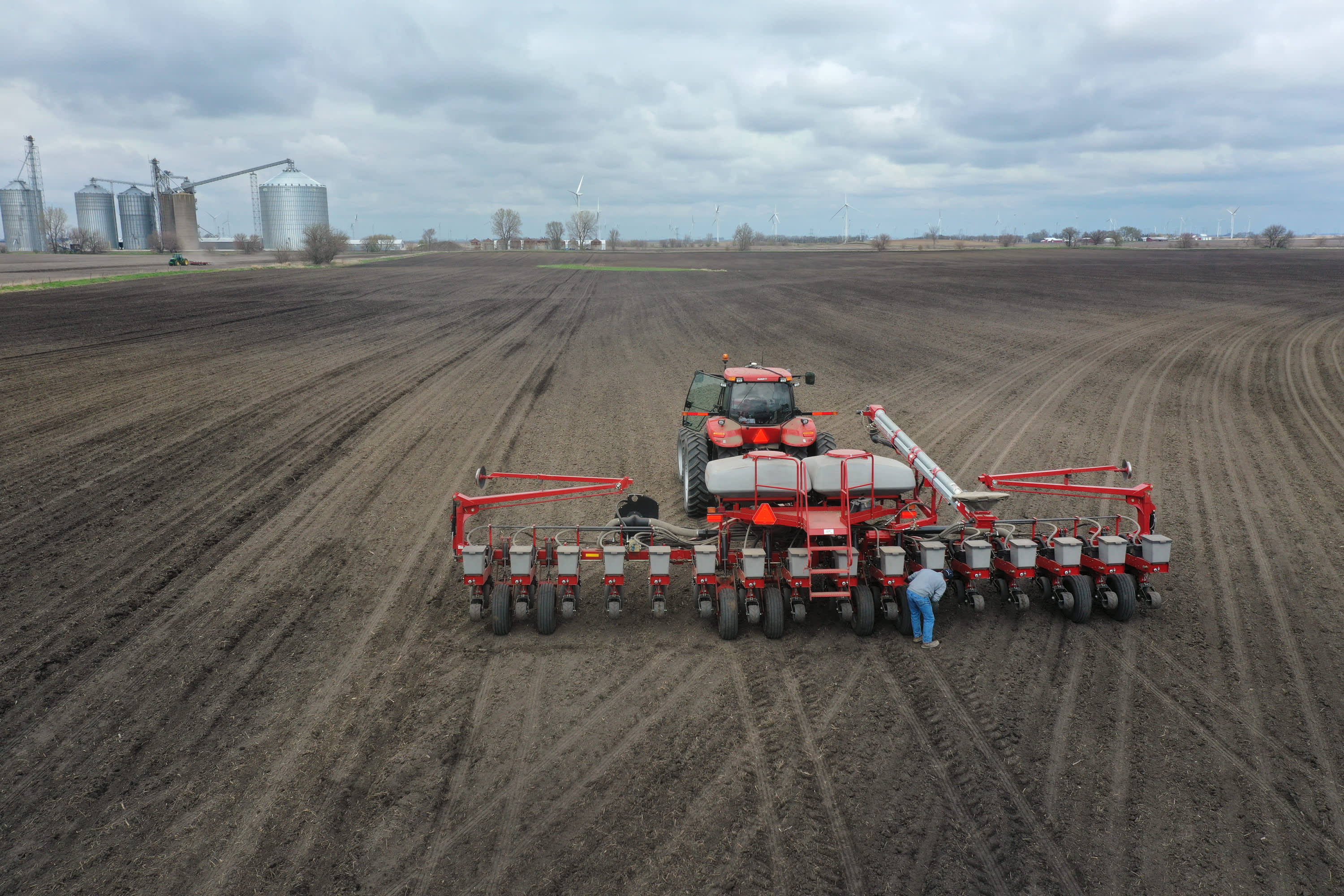An aerial view from a drone shows John Duffy planting corn on a farm he farms with his father on April 23, 2020 near Dwight, Illinois. Mild, dry weather has farmers in the state scrambling to get their fields planted.
Scott Olson | Getty Images
As a new U.S. president takes office, I am reminded of the words of our first president, George Washington, “I know of no pursuit in which more real and important services can be rendered to any country than by improving its agriculture.”
This year, we expect to see the rollout of ambitious new plans to address climate change. In his first day, President Joe Biden has brought the United States back into the Paris Agreement. He has indicated that he will make climate policy a central focus of his administration. By mid-year, detailed legislative proposals will be delivered to increase to 55% the 2030 greenhouse gas emission reduction target set by leaders across the EU’s 27-country bloc. China aims to be carbon neutral by 2060.
The global agriculture sector must play a key role in helping to bring these policy solutions to fruition. Today, agriculture is responsible for roughly 12% of all greenhouse gas emissions and 70% of freshwater consumption.
In many communities around the world, particularly in the United States, where 98% of farms are family owned, curbing climate change has become a matter of survival. Unpredictable changes in climate patterns, including increasingly severe floods, harsh droughts and heatwaves, violent storms, and early frosts all pose real and ever-present threats to farmers’ livelihoods and to our global food supply.
Yet history shows that agriculture is up to the challenges posed by climate change. Once a highly inefficient and unpredictable endeavor shaped by nature’s whims, farming has been revolutionized by innovation — major advances in crop protection, fertilization, and seeds over the past 60 years. This transition from Farming 1.0 to Farming 2.0 has yielded skyrocketing agricultural productivity. Compared with 1960, the world now produces 150% more food on only 13% more land, even as pesticide use on farmland has fallen 95% thanks to safer, more effective pest control solutions.
Tools for greater sustainability
The truly sustainable future of farming — I call it regenerative agriculture — is now taking shape. It’s a future driven by improving soil health and agriculture through digital technologies, and we are already catching glimpses of the benefits that these precision tools will deliver in the coming years.
Today, farmers can already use these data intensive tools to analyze their fields and obtain detailed “prescriptions” for more efficient and responsible treatment of their crops. Advancements in sensors and computer imaging let us identify highly precise spraying areas by considering smaller units, making it possible to manage variability within a field and allow for nuanced application of products and monitoring of crops. For example, “see-and-spray” technology enables farmers to create autonomous units directed by machine learning to facilitate spraying micro-doses of herbicides exclusively on weeds. Studies have shown that this technique can reduce herbicide use by more than 90%.
More from CNBC Environment:
How systemic change, circular economies and climate action are key to achieving green goals
Biden suspends oil and gas leasing in slew of executive actions on climate change
2020 was one of the hottest years on record, tied with 2016
Advanced analytics also provide insights that can make the difference between the failure and success of a crop. Massive amounts of data can be analyzed to create a power seed selection algorithm, helping farmers determine which seeds to plant, and where and how deep to plant them. Predictive algorithms can address another key concern — disease and pest intensity.
Additional tools use field scouting records to create optimal management zones. With such computer-aided scouting, images from satellites and drones can be used to assess whether sunlight is being absorbed and reflected by crops at the right levels. A timely, automated warning allows farmers to intervene before real problems emerge.
And the latest software in farm management systems offers end-to-end traceability of crops, making it possible to target consumers who want to buy from growers committed to responsible land use and low emissions. These cutting-edge tech solutions point the way to a better, greener and more sustainable future of farming to maintain an abundant and affordable food supply.
This is only a start. Putting modern technology into the hands of farmers to ensure they can make good decisions, such as improving the health of their soil and participating in carbon trading markets, will serve them well in a competitive marketplace. As regenerative agriculture becomes the norm, farmers will have access to more sound, scientific analysis and advice than ever before. Consumers will be provided with more information and more choice when it comes to selecting healthy and sustainable food for their families.
Every U.S. president has recognized the importance of agriculture. President Thomas Jefferson called agriculture “our wisest pursuit.” President Abraham Lincoln called it “the great calling.”
Under President Biden, we look forward to pursuing this noble calling in the service of the planet, so that we can safely feed the world and look after the environment.
—Erik Fyrwald is the CEO of Syngenta Group
